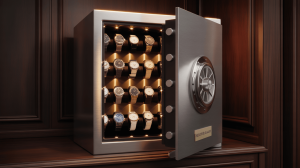A home safe with a built-in watch winder does more than lock. It secures your valuables behind thick steel. It keeps automatic watches wound and accurate. It organizes jewelry in padded drawers. You no longer juggle multiple devices. Every morning starts with a ready-to-wear timepiece and untangled necklaces. In 2025, top models blend security, technology, and style to fit any modern home. This guide explores the best options, explains crucial features, and helps you choose the perfect unit.
1. Why Choose a Dual-Function Safe
A dual-function safe combines security and convenience. Instead of separate safes and winders, you get one cohesive unit. This frees up space and reduces clutter. Your automatic watches remain wound with precise turns-per-day (TPD) cycles. Jewelry stays organized in velvet-lined drawers. Documents and small electronics fit into hidden compartments. You save time and avoid the hassle of resetting dates and untying chains. Overall, this integrated solution elevates daily routines and enhances home organization.
2. Security Ratings and Certifications
Security is paramount when storing valuables at home. Look for safes carrying UL RSC or ETL burglary certifications. These standards ensure resistance to pry bars and drills. For fire protection, UL 72 Class 350 ratings guarantee internal temperatures stay below 350 °F for at least 30 minutes. Some models extend protection to 60 minutes. Biometric or electronic locks prevent unauthorized access. Multi-point steel bolts and concealed hinges further deter forced entry. Bolt-down kits anchor the safe to floor joists or wall studs, making removal nearly impossible. Choosing a certified safe means you gain peace of mind.
3. Watch Winding Precision
Automatic watches rely on motion to maintain accuracy. Built-in watch winding modules recreate wrist movements at adjustable TPD settings. Entry-level models offer 650–1,200 TPD. Premium units provide up to 2,000 TPD or more. Direction control—clockwise, counterclockwise, or bi-directional—matches each watchmaker’s recommendations. Pause intervals prevent over-winding. High-quality Japanese or Swiss motors operate under 25 dB, ensuring quiet performance. Rubber-dampened mounts absorb vibration. This precise care preserves lubrication balance and extends service intervals.
| Feature | Specification | Benefit |
|---|---|---|
| TPD Range | 650–2,000 turns/day | Maintains accurate timekeeping |
| Direction Control | CW, CCW, Bi-directional | Protects winding mechanisms |
| Noise Level | < 25 dB | Barely audible operation |
4. Interior Layout for Jewelry Storage
A well-designed interior keeps jewelry safe and organized. Velvet-lined drawers cushion rings, earrings, and bracelets. Ring rolls hold bands upright. Earring posts keep pairs together. Necklace hooks suspend chains to prevent tangling. Some units include removable foam inserts for customization. Hidden lower drawers accommodate documents, spare straps, or small electronics. This modular layout ensures each piece has its dedicated spot. You avoid rummaging through mixed compartments and reduce the risk of scratches or loss.
5. Climate and Humidity Control
Leather watch straps and precious metals suffer in high humidity. Dust and moisture can damage delicate movements. Many safes feature IP54-rated door seals to block dust and water ingress. Passive desiccant chambers absorb excess moisture over time. Some premium models include active dehumidifiers to maintain 40–50 % relative humidity. Digital hygrometers display real-time readings, alerting you to potential risks. A stable micro-environment keeps leather supple, prevents tarnish, and protects internal electronics from corrosion.
6. Build Materials and Finish Options
The safe’s exterior should match your home décor while providing strength. Common materials include 12–14 gauge steel for walls and doors. Powder-coat finishes resist scratches and corrosion. Walnut veneer, hand-stitched leather wraps, and tempered glass panels add elegance. Hardware—hinges, locking bolts, and handles—often use corrosion-resistant alloys. Welded seams ensure structural integrity. Interior components use velvet, suede, or leather linings to protect valuables. High-end models allow custom finishes or engraving for a personalized touch.
| Material Component | Specification | Benefit |
|---|---|---|
| Exterior Steel | 12–14 gauge | Robust resistance to forced entry |
| Finish Options | Powder-coat, veneer, leather | Complements home décor |
| Interior Lining | Velvet, suede, leather | Prevents scratches and tarnish |
7. Noise and Vibration Levels
Even the best winding mechanism is useless if it’s disruptive. Watch winders rely on precision motors. Top models run under 25 dB—comparable to a whisper. Rubber-dampened motor mounts absorb vibration. Soft-close hinges prevent slamming noises. Silent locking bolts reduce clicking. This ensures the safe can reside in bedrooms or home offices without disturbing sleep or work. When running winding cycles nightly, you’ll barely notice the unit.
8. Smart Connectivity and Alerts
Modern safes connect to your smartphone via Bluetooth or Wi-Fi modules. Receive tamper, door-open, and low-battery alerts in real time. A dedicated app may allow remote lock/unlock, winding schedule adjustments, and humidity monitoring. Audit logs record access events with timestamps and user IDs. Enterprise-grade encryption protects these connections from hacking. Smart connectivity ensures you stay informed whether you’re home or away. If you travel frequently, you can adjust winding profiles and monitor security from anywhere.
9. Power Backup and Emergency Access
Watch winders and electronic locks require continuous power. Most safes include an AC adapter for daily operation. Rechargeable lithium-ion batteries provide backup during outages. Low-battery LED indicators and app notifications warn before depletion. A hidden mechanical override key or combination dial lets you access the safe if electronics fail. This layered power approach prevents lockouts and ensures watch winders remain active during temporary power loss.
| Power Option | Description | Benefit |
|---|---|---|
| AC Adapter | Primary power source | Continuous operation |
| Rechargeable Battery | Backup during outages | Maintains winding & locks |
| Mechanical Override | Hidden key or dial | Manual access if electronics fail |
10. Installation and Anchoring Tips
A properly installed safe maximizes security. First, locate floor joists or wall studs with a stud finder. Use heavy-duty lag or sleeve anchors rated for the safe’s loaded weight. Level the unit before fully tightening anchors to avoid door binding. For built-in installations, conceal anchor heads under interior liners or cabinetry trim for a sleek appearance. Professional installation is recommended for larger models to ensure stability, correct leveling, and optimal performance.
11. Maintenance and Longevity Practices
Routine care keeps the safe and valuables in peak condition. Dust exterior surfaces weekly using a microfiber cloth. Run empty winding cycles monthly to keep motors healthy. Test locks and electronics quarterly to confirm reliability. Replace desiccant packs every 6–12 months, based on local humidity levels. Swap backup batteries annually to maintain uninterrupted power. Lubricate mechanical components like locking bolts per manufacturer instructions. Maintain a service log to track dates, performance notes, and any observed issues.
12. Value and Cost Analysis
Failure to consider long-term value can lead to regrets. Home safes with built-in winders range from $1,500 to over $10,000. Entry-level units start around $1,500 for basic winder bays and jewelry drawers. Mid-range models ($2,500–$5,000) add climate control, LED lighting, and smart features. Premium safes ($5,000+) offer custom veneers, biometric locks, extended fire protection, and advanced connectivity. Insurance discounts for certified fire and burglary protection help offset initial costs. Over time, reduced watch servicing and fewer jewelry repairs balance the investment.
| Price Range | Features | Ideal Buyer |
|---|---|---|
| $1,500–$2,500 | 2–4 winder bays, basic drawers | Small collections, tight budgets |
| $2,500–$5,000 | Climate control, LED lighting, app | Mid-size collections, tech-savvy |
| $5,000+ | Custom finishes, biometric locks | Luxury buyers, large collections |
13. Brand Comparisons
Not all brands perform equally. TitanSecure models excel in budget-friendly security. GuardianVault units shine with smart connectivity and mid-range pricing. SecureGuard designs focus on compact form factors. FortKnox offers premium materials and dual-lock systems. LuxSecure leads the luxury segment with custom finishes and extended fire ratings. Research each brand’s warranty, customer support, and user reviews. Evaluate overall reliability, feature sets, and value retention when making your choice.
14. Space Planning and Design Integration
Your safe should fit seamlessly into your home’s layout. Compact countertop models (e.g., SecureGuard SlimLine) measure under 20 × 12 × 12 in. and fit on dressers or built-in shelves. Larger floor safes require dedicated floor space and clearance for swinging doors. Consider adjacent furniture and walking paths. Ensure easy access to power outlets for winder motors. If recessing the safe into cabinetry, plan for proper ventilation and wiring access.
| Model Type | Dimensions (in) | Placement Options |
|---|---|---|
| Countertop Compact | 18 × 10 × 12 | Dressers, shelves, built-ins |
| Mid-Size Cabinet | 24 × 18 × 18 | Closets, home offices, entryways |
| Floor Safe | 30 × 20 × 20 | Dedicated safe rooms, closets |
15. Making the Final Decision
Choosing the right safe depends on your priorities. If security is paramount, focus on UL RSC or ETL certified options with extended fire ratings. For watch collectors, prioritize winding precision and low noise levels. If jewelry organization matters, ensure ample padded drawers and adjustable storage. Tech enthusiasts should look for smart connectivity and remote monitoring. Measure available space and plan for installation. Finally, balance budget against desired features and long-term value. With careful consideration, you’ll find the perfect home safe that does much more than just lock.
FAQ
Q1: Can I store both quartz and automatic watches in the same safe?
Yes. Quartz watches remain static in designated trays, while automatic watches occupy winding bays.
Q2: How often do I need to replace desiccant packs?
Replace every 6–12 months based on your local humidity to maintain an optimal 40–50 % relative humidity.
Q3: Are biometric locks more secure than electronic keypads?
Biometric locks offer personalized access and are harder to share, but electronic keypads with time-delay settings also provide strong protection.
Q4: Do I need professional installation for larger safes?
Professional installation is recommended for floor or built-in safes to ensure proper anchoring, leveling, and stability.
Q5: How can I reduce winding noise?
Choose models with high-quality motors under 25 dB, rubber-dampened mounts, and precision bearings for whisper-quiet operation.







